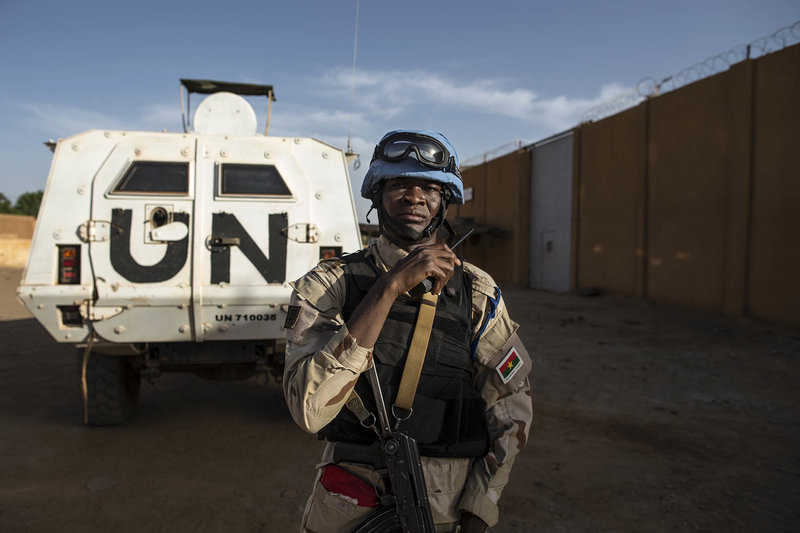The "Blue Helmets" are the United Nations' military personnel in the field. UN peacekeepers are provided by the different national armies of the UN's Member States.
UN military personnel work alongside UN Police and civilian colleagues to protect UN personnel and property; maintain close cooperation with other military entities in the mission area; and work to promote stability and security.
Every day, UN military personnel conduct patrols, providing vital security and stability in UN missions around the world.
UN military personnel work with local communities and local military personnel to bring about greater mutual understanding and to achieve lasting peace. The protection of civilians is very often at the heart of the mandate of UN peacekeeping missions and the Blue Helmets are key in providing security.
Countries contributing troops to MINUSMA
AUSTRALIA, AUSTRIA, BANGLADESH, BELGIUM, BENIN, BHUTAN, BURKINA FASO, BURUNDI, CAMBODIA, CAMEROON, CANADA, CHAD, CHINA, CZECHIA, DENMARK, EGYPT, EL SALVADOR, ESTONIA, FINLAND, FRANCE, GAMBIA, GERMANY, GHANA, GUATEMALA, GUINEA, INDONESIA, IRAN, ITALY, IVORY COAST, JORDAN, KENYA, LATVIA, LIBERIA, LITHUANIA, LUXEMBOURG, MAURITANIA, MEXICO, NEPAL, NETHERLANDS, NIGER, NIGERIA, NORWAY, PAKISTAN, PORTUGAL, ROMANIA, SENEGAL, SIERRA LEONE, SPAIN, SRI LANKA, SWEDEN, SWITZERLAND, TOGO, TUNISIA, UNITED KINGDOM, UNITED STATES OF AMERICA.
The Security Council authorized 13,289 military personnel for MINUSMA.
Global contribution for global peace
The UN has more than 97,000 uniformed personnel (Military and Police) coming from over 110 countries. They come from nations large and small, rich and poor. They bring different cultures and experiences to the job, but they are united in their determination to foster peace.
The UN has been deploying military personnel for service in peace operations since 1948, when the Security Council authorized the deployment of UN military observers to the Middle East to monitor the Armistice Agreement between Israel and its Arab neighbours.
UN military personnel can be called upon to:
- Monitor a disputed border
- Monitor and observe peace processes in post-conflict areas
- Provide security across a conflict zone
- Protect civilians
- Assist in-country military personnel with training and support
- Assist ex-combatants in implementing the peace agreements they may have signed
Getting involved
The UN seeks highly qualified military officers from UN Member States for service in peace missions around the world, either as individual Staff Officer, as Military Observer, or as part of a formed unit from an individual Troop-Contributing Country.
All military personnel working for the United Nations are first and foremost members of their own national armies and are then seconded to work with the UN for periods normally of up to one year in the field, or two years in the UN headquarters. Any queries about working for the UN in a military capacity should be addressed within an applicant's own country first.
By the end of 2012, 3.8% of UN military personnel were female. A top priority for UN military personnel is to increase the number of female military personnel in peacekeeping operations.
What kind of Blue Helmets are needed?
The most common kind of UN peacekeeper is the infantry soldier. However, there is an increasing need for personnel who we refer to as ‘enablers’. These skilled soldiers include engineers, who for example were able to help with the post-earthquake reconstruction in Haiti, or the building of new roads in South Sudan. We also need helicopters and their crews, as they enable us to extend our area of influence and be much more visible. Other specialist enablers include transport companies, communicators and medical personnel.
Modern peacekeeping operations are often very complex, and place high demands on the personnel we deploy. High levels of training are required before deployment, and the UN works closely with Troop-Contributing Countries to provide the best help and advice possible. Troops must know what to do if they find themselves in an ambush, for example, and must be capable of responding appropriately, even robustly, if necessary.
Why does the UN not have a standing reserve?
It takes considerable time to deploy troops and we are often asked why we do not have a standing reserve.
The UN can only deploy military personnel when there is a UN Security Council resolution authorizing them to do so. The Security Council will say how many military personnel are required, and then UN Headquarters will liaise with the Member States to identify personnel and deploy them. This can take time – perhaps more than six months from the date of the resolution.
As former UN Secretary-General Kofi Annan said, the UN is “the only fire brigade in the world that has to wait for the fire to break out before it can acquire a fire engine.” A standing reserve sounds logical, but it would be immensely costly to have a force of several thousand people on permanent standby. It would require training, accommodating, feeding, etc. and then might not even be used. Although it takes time, it is much more practical to generate the military personnel once the go-ahead has been given. This also ensures we recruit personnel with the appropriate background, training and language skills.
 UN
UN United Nations Peacekeeping
United Nations Peacekeeping

